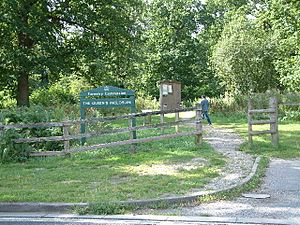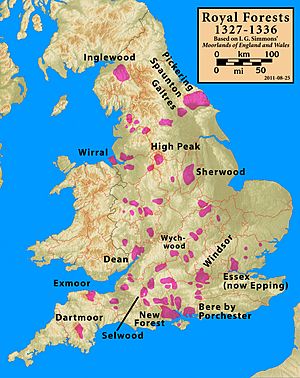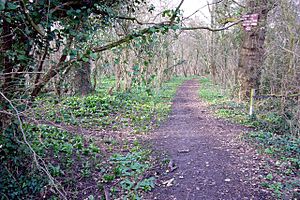Forest of Bere facts for kids
The Forest of Bere is a special natural area in Hampshire, England. It's located just north of towns like Fareham, Portsmouth, and Havant. A small part of it even touches the beautiful South Downs National Park.
This area was once a huge, unbroken forest. Today, it's a mix of different landscapes. You'll find woodlands, open spaces, ponds, and streams. There are also areas of heathland (open land with small shrubs) and downland (grassy hills). Farmland and small villages are scattered throughout. Larger towns like Waterlooville (with Cowplain) and Eastleigh (with Chandlers Ford) are also nearby. The Forest of Bere has many paths and bridleways. These are great for walking, cycling, and exploring nature. In the southern part, new conifer tree plantations were planted in the 1900s.
History of the Forest of Bere
The Forest of Bere has a long and interesting history. In the 1200s and 1300s, it was much larger. It was part of two big royal forests. These were special areas owned by the King or Queen. They were mainly used for hunting.
One part was called the Royal Forest of Bere Ashley. It was north of Southampton, between the River Test and the River Itchen. The other part was the Royal Forest of Bere Portchester. This was north of Portsmouth, between the River Meon and the area of Bedhampton. These two royal forests together formed a much bigger version of what we call the Forest of Bere today. Over time, parts of the forest were cleared for farming or towns. This is why it's now a mix of different landscapes.
Woodland Habitats and Country Parks
The Forest of Bere is home to many different types of woodlands. These woods provide homes for lots of plants and animals. While there are many small woods, some larger ones are important habitats.
Some of the notable woodlands and nearby country parks include:
- Southleigh Forest
- Staunton Country Park
- The Holt with Stein Wood and Havant Thicket
- The Queen's Inclosure in Waterlooville
- West Walk, which is one of the largest woods in the area.
- Manor Farm Country Park
- Itchen Valley Country Park
These areas offer important green spaces. They are vital for wildlife and for people to enjoy nature. They provide places for trees to grow and for animals to live. Many of these woods are connected by paths. This allows people to explore different parts of the forest.




